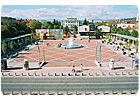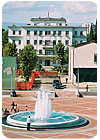

In addition to providing an aesthetically pleasing focal point for people to gather in Podgorica, which is considered to be Montenegro’s commercial center, the project also carries some political and historical significance. Formerly part of Yugoslavia, Montenegro became part of a republic with Serbia in 2003, and it didn’t achieve complete separation as its own republic until 2006. Given this timeline, the opening of the square in the fall of 2006 carried considerable importance for the citizens of Podgorica and Montenegro. “It was a particularly gratifying event given that Montenegro, a part of the former Yugoslavia, voted itself to statehood and independence from Serbia on May 21, 2006,” explained Amit Gupta of Tab India, the stone supplier for the project.
The stonework was the result of a six-month collaboration between Tab India and Maniro & Co. of Montenegro, the main stone contractor for the project.
The design of the project, conceived by architect Mladen Äurović, includes a variety of sandstone and limestone products in natural and honed finishes. In particular, Indian Chocolate sandstone, Indian Grey sandstone, Indian Tan Brown sandstone, Indian Autumn Brown sandstone and Indian Kota Blue were used to create a range of different patterns. Much of the main field is comprised of rust-colored sandstone carried within a lighter sandstone “grid.” Meanwhile, the square’s central fountain is surrounded by a circular pattern of Indian sandstone. The fountain itself is made of White Carrara marble, while New Bengal Black granite was also used for water features.
In selecting the stone, the architect and contractor looked at the success of Indian sandstone in other renovation projects within Europe, and they considered the material’s hardness and strength as well as its high visual appeal and quick delivery time from India, according to the company.
The stone was specified in various custom sizes with handcut edges and thicknesses of 1 and 2 inches. Sizes include 75 x 60, 75 x 90, 40 x 40, 30 x 60, 60 x 60, 30 x 30, 15 x 15 and 10 x 10 cm, among other sizes, as well as 20 cm x “free” varying lengths. In all, Tab India supplied over 75,000 square feet of stone (7,000 square meters) for the project.
“The project called for Tab to provide a vast amount of sandstone, cut to Maniro & Co.’s exact specifications,” Gupta explained. “From the arrival time of the various colors of sandstone provided by Tab India to the project site, there was less than one month until the inauguration ceremony took place on September 6.”
At the inaugural event, the Mayor of Podgorica, Miomir Mugosa, accompanied by the President of the Republic and the Prime Minister, officially “gave” the main city square to the citizens of Podgorica. “Seen as one of the first fruits of independence delivered to the people, Montenegro looks forward to a bright future as one of Europe’s shining stars, and Tab India looks forward to future collaborations,” said Gupta.


